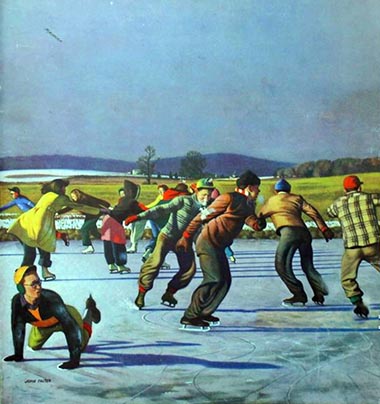Ice skating on Cottage Grove Lake? Yes, in 1949 — for two months
Historic cold snap let many Willamette Valley residents try out the sport for the first and, for many, only time.
EDITOR'S NOTE: A revised, updated and expanded version of this story was published in 2017 and is recommended in preference to this older one. To read it, click here.

This painting of skaters sporting about on a frozen lake is from the
cover of the Saturday Evening Post, Jan. 26, 1952. This is a scene
that, while common enough in the Midwest, has only been staged in
the Willamette Valley once ... in 1949.
By Finn J.D. John — Sept. 23, 2009
Earlier this year (January 2009), western Oregon got a brief cold snap along with enough snow to close down Interstate 5 and freeze a water pipe or two.
But it was nothing compared to what western Oregon was going through 50 years ago.
Those of you old enough to remember the winter of 1948-49 know exactly what I'm talking about. Maybe you even traveled to Cottage Grove Lake to join the crowd of 1,500 people gliding around on the six-to-10-inch ice covering the 100-acre reservoir from shore to shore.
If all that is before your time, perhaps you always thought Dad and Grandma were telling tall tales when they described skating on the Truax ponds near Riverside, or the Springfield mill race. Well, they weren't. It happened. What's more, it went on for a month and a half.
The ugly weather started on Dec. 12 in 1948, according to back issues of the Cottage Grove Sentinel. By the end of January, the cold spell had set a record, lasting for 45 days and plunging to one degree below zero on Jan. 24, 1949. Skaters started plying the frozen lake on Jan. 10, when the mercury plunged as low as seven degrees for the first time.
Oregon's timber-based economy skidded to a halt. The mills couldn't function in zero-degree weather. Log trucks and skid loaders were hard-put to avoid sliding off the narrow, twisting logging roads and landings they plied during normal weather — freeze everything solid and work in the woods was even more of a suicide run than before. And, of course, the schools were closed. So a whole lot of people had nothing to do but weld old files to the trucks of their roller skates and head out on the lake.
Skaters of all ages hit the lake, from toddlers to 91-year-old A.L. Woodard — who, according to the Sentinel, "took off across the lake where it was a mile from shore to shore and returned as though it were a daily habit."
It wasn't the coldest the valley had gotten — Christmas eve in 1924 saw seven degrees below zero — nor the most snow — 15 inches were on the ground on Feb. 24, 1917. But no other cold snap had ever come within a month of this one's duration. It nearly lasted the entire winter. It wasn't until Feb. 16 that warm, rainy weather roared into the valley as suddenly as the cold had come, melting the lake and sparking fears of more catastrophic flooding. (Remember, this was one year after the great flood of '48 drenched downtown Portland and swept away the town of Vanport.)
The flooding never materialized, though — at least, not that year. Mother Nature must have figured Oregonians had taken enough abuse for one winter.
(Sources: Cottage Grove Sentinel archives: Jan. 13, 20 and 27, 1949; Feb. 17, 1949)
-30-











